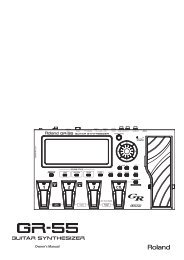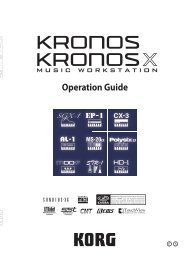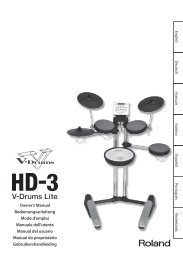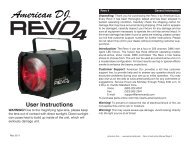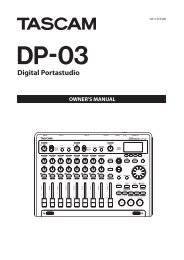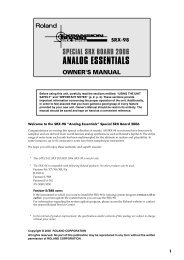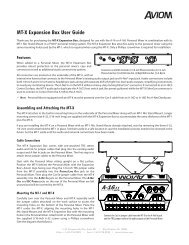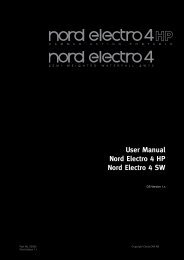Korg Microkorg Owner's Manual - zZounds.com
Korg Microkorg Owner's Manual - zZounds.com
Korg Microkorg Owner's Manual - zZounds.com
Create successful ePaper yourself
Turn your PDF publications into a flip-book with our unique Google optimized e-Paper software.
9. AMP EG — SYNTH/VOCODER<br />
Here you can make settings for the AMP EG, which applies time-variant change to the volume (➝Figure 9-1). By making AMP EG settings,<br />
you can make the volume change as time passes. Create the desired volume curve by adjusting the ADSR parameters; ATTACK (knob 1),<br />
DECAY (knob 2), SUSTAIN (knob 3), RELEASE (knob 4).<br />
You can use AMP EG as a Virtual Patch source to modulate parameters other than volume. (➝p.30)<br />
ATTACK [0...127]<br />
Specifies the time from note-on<br />
(when the key is pressed) until the<br />
attack level (maximum value of the<br />
envelope) is reached.<br />
DECAY [0...127]<br />
Specifies the time from when the attack<br />
level is reached until the sustain<br />
level (SUSTAIN) is reached.<br />
EG (Envelope Generator)<br />
To a significant extent, each sound has its own distinctive volume curve.<br />
For example when you play a note on a piano, the note begins at the<br />
maximum volume, and gradually diminishes. When you release your<br />
finger from the key, the sound will disappear quickly with a brief decay.<br />
Volume curves such as this are an important aspect of how we identify the<br />
sound of a specific instrument. This type of change also occurs in the tone<br />
and pitch, as well as in the volume. On a synthesizer, this type of change is<br />
produced by an EG. The microKORG has dedicated EGs for the filter and<br />
for the amp. However since these EGs can be used as Virtual Patch<br />
sources, you are also free to use them to vary the pitch or numerous other<br />
aspects of the sound.<br />
Some example settings are shown below.<br />
SUSTAIN [0...127]<br />
Specifies the volume that will be<br />
maintained after the decay time has<br />
elapsed, as long as you continue<br />
holding the key.<br />
Figure 9-1<br />
Level<br />
Attack Level<br />
0<br />
Note on<br />
[1]<br />
[2]<br />
[3]<br />
Note off<br />
RELEASE [0...127]<br />
Specifies the time from note-off<br />
(when the key is released) until the<br />
level reaches 0.<br />
[4]<br />
[1]: Attack Time [3]: Sustain Level<br />
[2]: Decay Time [4]: Release Time<br />
Time<br />
EG RESET<br />
[OFF, ON]<br />
Specifies whether or not the EG will<br />
be reset for the second and subsequent<br />
note-on. If a new note is<br />
played before the previous note has<br />
finished its release stage, the envelope<br />
can either start over from zero,<br />
or continue from the current value.<br />
OFF ( ):<br />
The note will start from the current<br />
EG level.<br />
ON ( ):<br />
The second note-on will start from<br />
a level of 0.<br />
OFF<br />
ON<br />
Note on<br />
Note off<br />
Note on (Retrigger)<br />
Piano<br />
Level<br />
Note on<br />
Note off<br />
0 Time<br />
Organ<br />
Level<br />
Note on<br />
Note off<br />
0 Time<br />
Strings<br />
Level<br />
Note on<br />
Note off<br />
0 Time<br />
The "EG RESET" parameter is<br />
available only when "VOICE<br />
ASSIGN" is Poly, or when<br />
"VOICE ASSIGN" is Mono or<br />
Unison and "TRIGGER" is Multi.<br />
Attack: 0 Sustain: 0<br />
Decay: 100 – 127 Release: 5–25<br />
Attack: 0 Sustain: 127<br />
Decay: — Release: 0<br />
Attack: 40 Sustain: 75<br />
Decay: 50 Release: 50<br />
28



